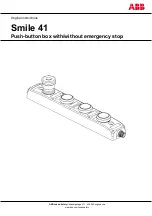
GE Power Management
745 Transformer Management Relay
10-35
10 COMMISSIONING
10.6 PROTECTION SCHEMES
10
10.6.17 UNDERFREQUENCY 1
a) PRELIMINARIES
Disable all protection functions except the Underfrequency 1 function. Verify that settings match the in-service
requirements. Settings can be entered or modified under:
SETPOINTS/S4 ELEMENTS/FREQUENCY/UNDERFREQUENCY 1/...
b) VOLTAGE INPUT FUNCTION (VOLTAGE INPUT ENABLED)
1.
Using the variable-frequency voltage/current source connected to terminals C11 and C12 for the voltage
signal and H1 and G1 for the current signal, set the frequency to 60.00 Hz (or 50.00 Hz for 50 Hz systems)
and the voltage amplitude to the rated VT secondary voltage.
2.
Set the current amplitude to rated CT secondary. Monitor the appropriate trip and auxiliary relays. Reset all
alarms and indications on the relay. The relay display should remain with no trip indications.
3.
Slowly decrease the frequency until the output relay(s) operate. Check that the operation took place at the
selected frequency setting.
4.
As the frequency is varies, verify that the correct system frequency is displayed under:
ACTUAL VALUES/A2 METERING/FREQUENCY/SYSTEM FREQUENCY
5.
Slowly reduce the voltage and note the voltage at which the output relay(s) reset. Check that this dropout
voltage is approximately the value of voltage supervision set under.
SETPOINTS/S4 ELEMENTS/FREQUENCY/UNDERFREQUENCY 1/MINIMUM OPERATING VOLTAGE
If voltage supervision is set to 0.0, then the element remains operated until the voltage is
decreased below approximately 2%, the level at which measurements become unreliable.
6.
Slowly increase the voltage and check that the element operates when the voltage reaches 2% above the
supervision level. Return the voltage to nominal value.
7.
Slowly decrease the current until the element resets. Check that this dropout current level is equal to the
setting:
SETPOINTS/S4 ELEMENTS/FREQUENCY/UNDERFREQUENCY 1/MINIMUM OPERATING CURRENT
If current sensing is disabled in the element, it will remain operated with current reduced to 0.0 A.
8.
Slowly increase the current and ensure the element operates when the current reaches a value just above
the setting. Set the current to rated CT secondary.
9.
Check that the TRIP and PICKUP LEDs are on and the following trip message is displayed:
10. Slowly increase the frequency until the PICKUP indicator and output relays reset. Note the dropout level,
which should be the pickup plus 0.03 Hz. Check that the TRIP indicator is still on. The trip message will
stay on if the TARGET setting is
Latched
; if set to
Self-resetting
, the message will reset when frequency is
above the setpoint.
11. For timing tests, the signal generator must be capable of triggering into step-wise changing of frequency or
ramping down to a pre-selected frequency in only a few milliseconds. Connect the Signal Source and
Timer Start triggers as shown in Figure 10–11: FREQUENCY ELEMENT TESTING on page 10–34.
yy
LATCHED (OPERATED):
yy
Underfrequency 1
NOTE
NOTE
Summary of Contents for 745 TRANSFORMER MANAGEMENT RELAY
Page 30: ...2 8 745 Transformer Management Relay GE Power Management 2 3 SECURITY 2 GETTING STARTED 2 ...
Page 210: ...7 36 745 Transformer Management Relay GE Power Management 7 2 BLOCK DIAGRAMS 7 SCHEME LOGIC 7 ...
Page 322: ...9 12 745 Transformer Management Relay GE Power Management 9 3 USING 745PC 9 745 PC SOFTWARE 9 ...
Page 396: ...A 4 745 Transformer Management Relay GE Power Management A 1 FIGURES AND TABLES APPENDIXA A ...
Page 400: ...C 2 745 Transformer Management Relay GE Power Management C 1 WARRANTY INFORMATION APPENDIXC C ...
Page 406: ...vi 745 Transformer Management Relay GE Power Management ...
Page 407: ...GE Power Management 745 Transformer Management Relay NOTES ...










































